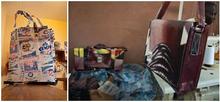fabric or leather, and were worn by men as often as ladies; the Scottish sporran is a survival of this custom. By the late 18th century, fashions in Europe were moving towards a slender shape, inspired by the silhouettes of Ancient Greece and Rome. Women wanted purses that would not be bulky or untidy in appearance, so reticules were designed. Reticules were made of fine fabrics like silk and velvet, with wrist straps. Originally popular in France, they crossed over into Britain, where they became known as "indispensables".[2] Men, however, did not adopt the trend. They used purses and pockets, which became popular in men's trousers.[3]
The modern purse or handbag came about in England during the Industrial Revolution and the increase in travel by railway. In 1841 the Doncaster industrialist and confectionery entrepreneur Samuel Parkinson (of butterscotch fame) ordered a set of travelling cases and trunks, and insisted on a travelling case or bag for his wife's particulars. Parkinson had noticed his wife's purse was too small and made from material that would not withstand the journey. He stipulated that he wanted various hand bags for his wife, varying in size for different occasions, and asked that they be made from the same leather that was being used for his cases and trunks; this would distinguish them from the then-familiar carpetbag and other travelers' cloth bags used by members of other social classes. H. J. Cave (London) obliged and produced the first modern set of luxury handbags, as we would recognise them today, including a clutch and a tote (named as 'ladies travelling case'). These are now on display in the handbag museum in Amsterdam.[4] H. J. Cave did continue to sell and advertise the handbags, but many critics said that women did not need them, and that bags of such size and heavy material would 'break the backs of ladies'. H. J. Cave ceased to promote the bags from 1865 on, and concentrated on trunks instead, although they still make the odd handbag for Royalty, celebrities or to celebrate special occasions, the Queens 2012 Diamond Jubilee being the most recent. However, Cave's design lives on, and the use of leather has not been found to break many ladies' backs.[citation needed]






















